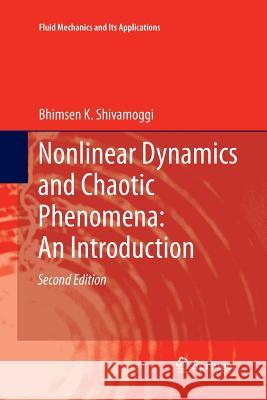Nonlinear Dynamics and Chaotic Phenomena: An Introduction » książka



Nonlinear Dynamics and Chaotic Phenomena: An Introduction
ISBN-13: 9789401777117 / Angielski / Miękka / 2016 / 375 str.
Nonlinear Dynamics and Chaotic Phenomena: An Introduction
ISBN-13: 9789401777117 / Angielski / Miękka / 2016 / 375 str.
(netto: 633,05 VAT: 5%)
Najniższa cena z 30 dni: 660,61
ok. 30 dni roboczych
Dostawa w 2026 r.
Darmowa dostawa!
This book clearly details the basic concepts, language and results of nonlinear dynamical systems. It serves as an ideal reference to first-year graduate students and theoretically inclined researchers in the physical sciences and engineering.
1 Nonlinear Ordinary Differential Equations.- 1.1 First-order Systems.- 1.1.1 Dynamical System.- 1.1.2 Lipschitz Condition.- 1.1.3 Gronwall’s Lemma.- 1.1.4 Linear Equations.- 1.1.5 Autonomous Equations.- 1.1.6 Stability of Equilibrium Points.- 1.1.6.1 Liapunov and Asymptotic Stability.- 1.1.6.2 Liapunov Function Method.- 1.1.7 Center Manifold Theorem.- 1.2 Phase-plane Analysis.- 1.3 Fully Nonlinear Evolution.- 1.4 Non-autonomous Systems.- 2 Bifurcation Theory.- 2.1 Stability and Bifurcation.- 2.2 Saddle-Node, Transcritical and Pitchfork Bifurcations.- 2.3 Hopf Bifurcation.- 2.4 Break-up of Bifurcations under Perturbations.- 2.5 Bifurcation Theory of One-Dimensional Maps.- 2.6 Appendix: The Normal Form Reduction.- 3 Hamiltonian Dynamics.- 3.1 Hamilton’s Equations.- 3.2 Phase Space.- 3.3 Canonical Transformations.- 3.4 The Hamilton-Jacobi Equation.- 3.5 Action-Angle Variables.- 3.6 Infinitesimal Canonical Transformations.- 3.7 Poisson’s Brackets.- 4 Integrable Systems.- 4.1 Separable Hamiltonian Systems.- 4.2 Integrable Systems.- 4.3 Dynamics on the Tori.- 4.4 Canonical Perturbation Theory.- 4.5 Komogorov-Arnol’d-Moser Theory.- 4.6 Breakdown of Integrability and Criteria for Transition to Chaos.- 4.6.1 Local Criteria.- 4.6.2 Local Stability vs. Global Stability.- 4.6.3 Global Criteria.- 4.7 Magnetic Island Overlap and Stochasticity in Magnetic Confinement Systems.- 4.8 Appendix: The Problem of Internal Resonance in Nonlinearly-Coupled Systems.- 5 Chaos in Conservative Systems.- 5.1 Phasse-Space Dynamics of Conservative Systems.- 5.2 Poincar´e’s Surface of Section.- 5.3 Area-preserving Mappings.- 5.4 Twist Maps.- 5.5 Tangent Maps.- 5.6 Poincar´e-Birkhoff Fixed-Point Theorem.- 5.7 Homoclinic and Heteroclinic Points.- 5.8 Quantitative Measures of Chaos.- 5.8.1 Liapunov Exponents.- 5.8.2 Kolmogorov Entropy.- 5.8.3 Autocorrelation Function.- 5.8.4 Power Spectra.- 5.9 Ergodicity and Mixing.- 5.9.1 Ergodicity.- 5.9.2 Mixing.- 5.9.3 Baker’s Tranformation.- 5.9.4 Lagrangian Chaos in Fluids.- 6 Chaos in Dissipative Systems.- 6.1 Phase-Space Dynamics of Dissipative Systems.- 6.2 Strange Attractors.- 6.3 Fractals.- 6.3.1 Examples of Fractals.- 6.3.2 Box-Counting Method.- 6.4 Multi-fractals.- 6.5 Analysis of Time Series Data.- 6.6 The Lorenz Attractor.- 6.6.1 Equilibrium Solutions and Their Stability.- 6.6.2 Slightly Supercritical Case.- 6.6.3 Existence of an Attractor .- 6.6.4 Chaotic Behavior of the Nonlinear Solutions.- 6.7 Period-Doubling Bifurcations.- 6.7.1 Difference Equations.- 6.7.2 The Logistic Map.- 6.8 Appendix: The Hausdorff-Besicovitch Dimension.- 6.9 Appendix: The Derivation of Lorenz’s Equations.- 6.10 Appendix: The Derivation of Universality for One-Dimensional Maps.- 7 Solitons.- 7.1 Fermi-Pasta-Ulam Recurrence.- 7.2 Korteweg-deVries Equation.- 7.3 Waves in an Anharmonic Lattice.- 7.4 Shallow Water Waves.- 7.5 Ion-acoustic Waves.- 7.6 Basic Properties of Korteweg-deVries Equation.- 7.6.1 Effect of Nonlinearity.- 7.6.2 Effect of Dispersion.- 7.6.3 Similarity Transformation.- 7.6.4 Stokes Waves: Periodic Solutions.- 7.6.5 Solitary Waves.- 7.6.6 Peridic Cnoidal Wave Solutions.- 7.6.7 Interacting Solitary Waves: Hirota’s Method.- 7.7 Inverse-Scattering Transform Method.- 7.7.1 Time Evolution of the Scattering Data.- 7.7.2 Gel’fand-Levitan-Marchenko Equation.- 7.7.3 Direct Scattering Problem.- 7.7.4 Inverse-Scattering Problem.- 7.8 Conservation Laws.- 7.9 Lax Formulation.- 7.10 B¨acklund Transformations.- 8 Singularity Analysis and the Painlev´e Property of Dynamical Systems.- 8.1 The Painlev´e Property.- 8.2 Singularity Analysis.- 8.3 The Painlev´e Property for Partial Differential Equations.- 9 Fractals and Multi-Fractals in Turbulence.- 9.1 Scale Invariance of the Navier-Stokes Equations and the Kolmogorov (1941) Theory.- 9.2 The β -model for Turbulence.- 9.3 The Multi-fractal Models.- 9.4 The Random-β Model.- 9.5 The Transition to Dissipation Range.- 9.6 Critical Phenomena Perspectives on the Turbulence Problem.- 10 Exercises.- 11 References.- 12 Index.
This book starts with a discussion of nonlinear ordinary differential equations, bifurcation theory and Hamiltonian dynamics. It then embarks on a systematic discussion of the traditional topics of modern nonlinear dynamics -- integrable systems, Poincaré maps, chaos, fractals and strange attractors. The Baker’s transformation, the logistic map and Lorenz system are discussed in detail in view of their central place in the subject. There is a detailed discussion of solitons centered around the Korteweg-deVries equation in view of its central place in integrable systems. Then, there is a discussion of the Painlevé property of nonlinear differential equations which seems to provide a test of integrability. Finally, there is a detailed discussion of the application of fractals and multi-fractals to fully-developed turbulence -- a problem whose understanding has been considerably enriched by the application of the concepts and methods of modern nonlinear dynamics. On the application side, there is a special emphasis on some aspects of fluid dynamics and plasma physics reflecting the author’s involvement in these areas of physics. A few exercises have been provided that range from simple applications to occasional considerable extension of the theory. This book has grown out of the author’s lecture notes for an interdisciplinary graduate-level course on nonlinear dynamics. The basic concepts, language and results of nonlinear dynamical systems are described in a clear and coherent way. In order to allow for an interdisciplinary readership, an informal style has been adopted and the mathematical formalism has been kept to a minimum.
This book is addressed to first-year graduate students in applied mathematics, physics, and engineering, and is useful also to any theoretically inclined researcher in the physical sciences and engineering.
This second edition constitutes an extensive rewrite of the text involving refinement and enhancement of the clarity and precision, updating and amplification of several sections, addition of new material like theory of nonlinear differential equations, solitons, Lagrangian chaos in fluids, and critical phenomena perspectives on the fluid turbulence problem and many new exercises.
1997-2025 DolnySlask.com Agencja Internetowa
KrainaKsiazek.PL - Księgarnia Internetowa









